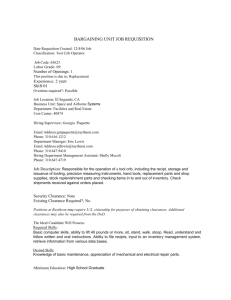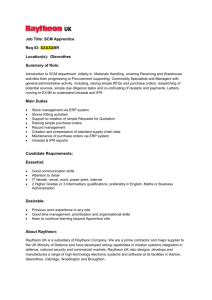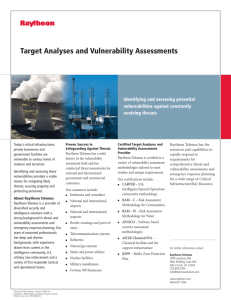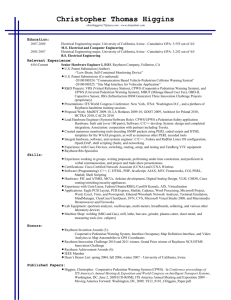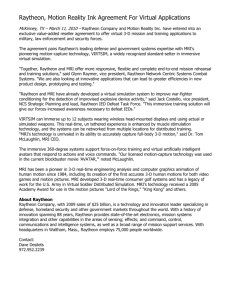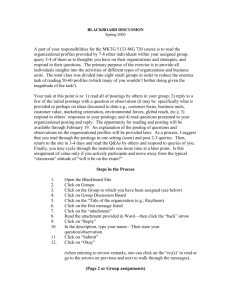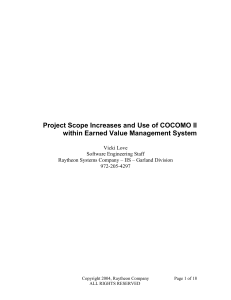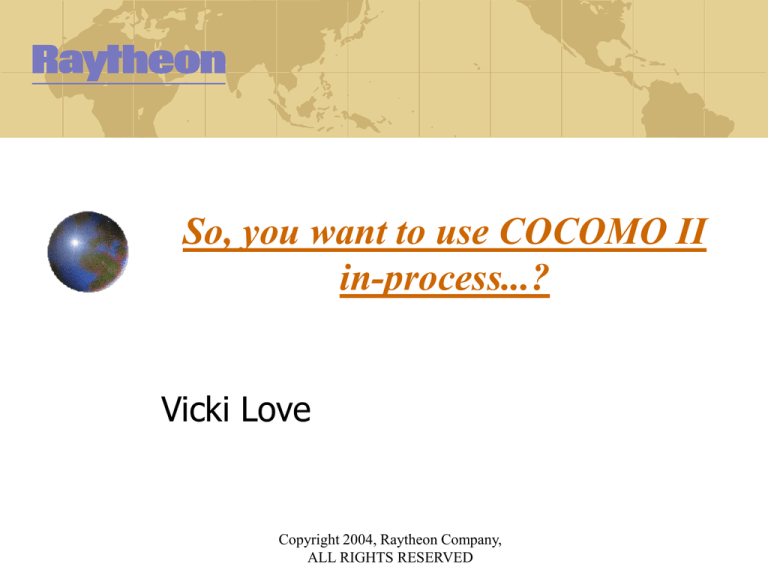
So, you want to use COCOMO II
in-process...?
Vicki Love
Copyright 2004, Raytheon Company,
ALL RIGHTS RESERVED
Agenda
Terminology
Software Development Effort Models
Earned Value Management System
In-process Usage of Effort Models
Alternatives for Bidding
Summary
Backup Charts
Copyright 2004, Raytheon Company,
ALL RIGHTS RESERVED
2
Terminology
Software Development Effort Model
Used to estimate effort to develop a software
system
• i.e. COCOMO II, SEER, Price S
Earned Value Management System (EVMS)
Facilitates management of a project’s
technical, schedule, and budget scope
Focuses on deviations from the project plans
Copyright 2004, Raytheon Company,
ALL RIGHTS RESERVED
3
Software Development Effort Models
A Parametric Cost Model “… series of cost
estimating relationships (CERs), ground rules,
assumptions, relationships, constants, and
variables that describe and define the situation
or condition being studied”… from Parametric
Cost Estimating Handbook
Local calibration of models encouraged using
data from completed projects
Project characteristics
End project size
Total project effort
Copyright 2004, Raytheon Company,
ALL RIGHTS RESERVED
4
Software Development Effort Models
Size and Effort
1250000
Effort (Hours)
1000000
750000
500000
250000
0
0
100
200
300
400
500
600
700
800
900
Size (KESLOC)
Example Parametric Size/Effort Relationship
Constant Size/Effort Relationship Using 400 KESLOC Productivity
Size and Productivity
Productivity
(ESLOC/Hour)
1.5
In general, parametric models
assume a non-linear relationship
between size of project and the
effort required to complete the
project; the bigger a project is, the
less productive it is. This is called
“diseconomy of scale”.
0.75
0
0
100
200
300
400
500
600
700
800
900
Size (KESLOC)
Example Parametric Size/Effort Relationship
Constant Size/Effort Relationship Using 400 KESLOC Productivity
•These examples use COCOMO II model with Inductry calibration
Copyright 2004, Raytheon Company,
ALL RIGHTS RESERVED
5
Software Development Effort Models
Size and Effort
1
0.95
1000000
0.9
750000
500000
0.85
250000
0.8
Schedule
Compression
Effort (Hours)
1250000
0.75
0
0
100
200
300
400
500
600
700
800
900
Size (KESLOC)
Example Parametric Size/Effort Relationship
Constant Size/Effort Relationship Using 400 KESLOC Productivity
Schedule Compression by Size
Size and Productivity
When schedule compression
becomes a factor, the deviation
becomes even more significant.
Productivity
(ESLOC/Hour)
0.95
0.9
0.75
0.85
0.8
Schedule
Compression
1
1.5
0.75
0
0
100
200
300
400
500
600
700
800
900
Size (KESLOC)
Example Parametric Size/Effort Relationship
Constant Size/Effort Relationship Using 400 KESLOC Productivity
•These examples use COCOMO II model with Industry calibration.
Schedule constrained to nominal schedule for 400 KESLOC project (all
projects bigger than 400KESLOC are compressed)
Schedule Compression by Size
Copyright 2004, Raytheon Company,
ALL RIGHTS RESERVED
6
Software Development Effort Model
** Implication is
that each bid is
modeled as if it is
an end of program
size, schedule, etc.
Project
Development
Effort
Copyright 2004, Raytheon Company,
ALL RIGHTS RESERVED
7
Earned Value Management System
Project
Development
Effort
Project Schedule
Activities/Budget
Links to other activities
Weekly Status Input
Collection of Actuals
Copyright 2004, Raytheon Company,
ALL RIGHTS RESERVED
8
In-process Usage of Effort Models
Project
Development
Effort
Many benefits to In-process Use
Facilitates generation of latest best
estimates of project size/effort
Facilitates data feedback into
organization repository
Improves accuracy of bids
But – in-process use of Effort
Models along with EVMS is
Copyright 2004, Raytheon Company,
tricky...
ALL RIGHTS RESERVED
Project Schedule
Weekly Status Input
Collection of Actuals
9
In-process Usage of Effort Models
NEW Project
Development
Effort
J
Activities and associated
budget reflect productivity for
project start size/schedule
Copyright 2004, Raytheon Company,
ALL RIGHTS RESERVED
10
Alternatives for Bidding
Fold in “productivity
impacts” as scope
changes
** Use start program
sizes instead of end sizes
Generate estimated project
productivity w/scope increase (via
Copyright 2004, Raytheon Company, REVL parm or additional ESLOC); rerun
model without scope increase11using
ALL RIGHTS RESERVED
estimated productivity
Is It Worth It?
Actual results
On 3 year+ project with ~600K ESLOC
• Actual development effort within 7% of model projected
• Total software effort projected to be within 5%
Customer satisfaction VERY high
• Director of agency – “<PROJECT> is the model project for <this
agency>. It’s on schedule, within budget, has a great team supporting it
– it’s the way we’d like all our programs to work!”
• Customer office program manager – “The highest scored program
reviewed...in the entire intelligence community as an Information
Technology investment”
• Customer office program manager – “The program that carried <the
agency> to an iCMM (software maturity) level 3 award.”
Copyright 2004, Raytheon Company,
ALL RIGHTS RESERVED
12
Additional Information
Paper – “Project Scope Increases and Use of
COCOMO II with Earned Value Management
System”
More detailed information of issues encountered with
EVMS and lessons learned along the way
Comparison of all three alternatives
Vicki Love – Raytheon Systems Company
Vicki_A_Love@raytheon.com
972-205-4297
Copyright 2004, Raytheon Company,
ALL RIGHTS RESERVED
13

